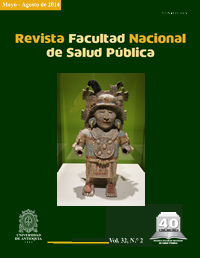Dental Rehabilitations and Temporomandibular Disorders in Adolescents of Puebla, Mexico
DOI:
https://doi.org/10.17533/udea.rfnsp.15577Keywords:
temporomandibular disorders, relative risk, dental cavities, cohort study, dental resinAbstract
Downloads
References
(1). Dworkin, SF, LeResche, L. Research diagnostic criteria for tem-poromandibular disorders: review, criteria, examinations and specifications, critique. Journal Craniomandibular Disorder 1992; 6 (4): 301-355.
(2). Casanova J, Medina C, Vallejos A, Casanova A, Hernández B, AvilaL. Prevalence and associated factors for temporomandibu-lar disorders in a group of Mexican adolescents and youth adults. Clin Oral Investigation 2006; 10 (1): 42-49. DOI: https://doi.org/10.1007/s00784-005-0021-4
(3). Espinosa I. Relación de desórdenes temporomandibulares-perfil psicológico en estudiantes de Puebla. Revista Odontológica Mexi-cana 2006; 10 (3), 115-118. DOI: https://doi.org/10.22201/fo.1870199xp.2006.10.3.15898
(4). Moyaho A, Espinosa I, Torres M, Vaillard E. Valoración integral de los trastornos temporomandibulares en pacientes pediátricos (caso clínico). Revista Odontológica Mexicana 2008; 12 (4), 168-172. DOI: https://doi.org/10.22201/fo.1870199xp.2008.12.4.15623
(5). Suvinen T, Reade P, HanesK, KononenM, KemppainenP. Tempo-romandibular disorder subtypes according to self-reported physi-cal and psychosocial variables in female patients: a re-evaluation. J Oral Rehabilitation 2005; 32 (3): 166-173. DOI: https://doi.org/10.1111/j.1365-2842.2004.01432.x
(6). Miyake R, Ohkubo R, Takehara J, Morita M. Oral parafunctions and association with symptoms of temporomandibular disorders in Japanese university students J Oral Rehabilitation 2004; 31 (6): 518-523. DOI: https://doi.org/10.1111/j.1365-2842.2004.01269.x
(7). Yrsa Le B, Paivi M, Niemi, Tapio Jamsa, Mervi Kylmalala. Sub-jetive reaccions to intervention with artificial interferences in sub-jects with and without a history of temporomandibular disorders. Acta Odontológica Escandinavica, 2006; 64: 59-63 DOI: https://doi.org/10.1080/00016350500419867
(8). Muñoz Q, Vázquez de Lara LG, Espinosa I.Asociación entre hábi-tos parafuncionales de la cavidad bucal y los trastornos temporo-mandibulares en adolescentes. Odontología Pediátrica. 2011 Vol. 10 Nº 2: 90-94
(9). Poveda R, Bagan J, Díaz Fernández J, Hernández B, Jiménez S. Revisión de la patología de la articulación temporomandibular. Parte I: clasificación, epidemiología y factores de riesgo. Med Oral Patol Oral Cir Bucal 2007; 12: E292-E298
(10). Kampe T, Hannerz H, Strom, P. Mandibular dysfunction related to dental filling therapy. A comparative anamnestic and clinical study. Acta Odontol Scand, 1986; 44 (2): 113-121. DOI: https://doi.org/10.3109/00016358609041316
(11). Troeltzsch M, Troeltzsch M, Cronin RJ, Brodine AH, Frankenber-berg R, Messlinger K. Prevalence and association of headaches, temporomandibular joint disorders, and occlusal interferences. J Prosthet Dental 2011; 105 (6): 410-417 DOI: https://doi.org/10.1016/S0022-3913(11)60084-X
(12). Dodic S , Sinobad V , Obradovic-Djuričić K. The role of occlusal factor in the etiology of temporomandibular dysfunction. Srp Arh Celok Lek 2009: 137 (11-12): 613-8. DOI: https://doi.org/10.2298/SARH0912613D
(13). Kampth T, Hannerz H. Five-year longitudinal study of adoles-cents with intact and restored dentitions: signs and symptoms of temporomandibular dysfunction and functional. Journal of Oral Rehabilitation 1991; 18: 387-398 DOI: https://doi.org/10.1111/j.1365-2842.1991.tb01683.x
(14). González YM, Miranda-Rivera Y, Espinosa I. Cross-cultural adaptation of research diagnostic criteria for temporomandibu-lar disorders (RDC/TMD). Rev Fac Odontol Univ Antioq 2013; 25(1): 11-25
(15). Takehara J, Honda O, Morita M. Association of caries and treatment experiences with subjective symptoms of temporo-mandibular disorders in female adolescents. J Oral Rehabilitation 2004; 31 (7): 623-627. DOI: https://doi.org/10.1111/j.1365-2842.2004.01270.x
(16). Huang G, LeRescheL, Critchlow,CW, Martin,MD, DrangsholtM. Risk factors for diagnostic subgroups of painful temporomandibu-lar disorders (TMD). J Dental Res 2002; 81 (4): 284-288. DOI: https://doi.org/10.1177/154405910208100412
(17). Jeffrey P Okeson. Tratamiento de oclusión y afecciones temporo-mandibulares. Barcelona: Elsevier Editorial; 2008, p 140.
Downloads
Published
How to Cite
Issue
Section
License
Copyright (c) 2021 Gabriel Muñoz Q., Luis G. Vázquez De Lara C., Irene A. Espinosa, Martha A. Delgado M.

This work is licensed under a Creative Commons Attribution-NonCommercial-ShareAlike 4.0 International License.
The contents of the articles are the responsibility of the authors
The editorial committee has editorial independence from the National School of Public Health "Héctor Abad Gómez" of the University of Antioquia.
The editorial committee is not responsible for aspects related to copying, plagiarism or fraud that may appear in the articles published in it.
When you are going to reproduce and disclose photographs or personal data in printed or digital format, informed consent is required. Therefore, this requirement is required of the author at the time of receipt of the manuscript.
Authors are responsible for obtaining the necessary permissions to reproduce any material protected by reproduction rights.
The authors preserve the moral rights and assign the economic rights that will correspond to the University of Antioquia, to publish it, distribute electronic copies, include them in indexing services, directories or national and international databases in Open Access, under the Creative Commons Attribution license -Not Commercial-Share Equal 4.0 International Commercial (CC BY-NC-SA) which allows others to distribute, remix, retouch, and create from the work in a non-commercial way, as long as the respective credit and license are granted. new creations under the same conditions.
The authors will sign the declaration of transfer of economic rights to the University of Antioquia, after the acceptance of the manuscript.
The editorial committee reserves the right to reject the articles whose authors do not offer satisfactory explanations about the contribution of each author, to meet the criteria of authorship in the submission letter. All authors must meet the four criteria of authorship according to ICMJE: "a) .- That there is a substantial contribution to the conception or design of the article or to the acquisition, analysis or interpretation of the data. b) That they have participated in the design of the research work or in the critical review of its intellectual content. c) .- That has been intervened in the approval of the final version that will be published.d). That they have the capacity to respond to all aspects of the article in order to ensure that issues related to the accuracy or integrity of any part of the work are adequately investigated and resolved. "












 --
--  --
--
